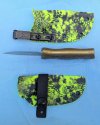Good tips! I may try multiple layers of the blue painters tape. I used to just do 2 or 3 (for damascus blades) layers of the blue painters tape, but over the years, it has gotten thinner. Duct tape thickness varies with different brands, too, so I did some testing to come up with my layer stack. Damascus blades get an extra layer of gorilla tape to give plenty of clearance on the blade. The Gorilla tape sometimes leaves a sticky gummy residue inside the sheath though.
I do all of my drilling, countersinking and shaping (and started keeping the eyelets farther from the edge) and polishing and chamfering of the outside edges. I used to flush out with water and paper towels wrapped around a thin butter knife blade to clean the inside. I also usually use the back of a utility knife blade to make sure any kydex burrs are gone from the inside of the holes and the edges and then run some folded up 400-600 grit sandpaper through the sheath where the eyelets and seams are, but I started using Denatured Alcohol on paper towel instead of the water to clean the inside of the sheath out since it helps get rid of the tape residue as well as the kydex dust. Once it's cleaned and dried, I set the eyelets and then use the heat gun to tweak the opening to flare it and make sure the handle has good retention. I usually have a palm swell, and the front of the handle flares up (but the leading edge is rounded) a bit, so I have to open up the sheath opening for that and adjust the tension. For testing the retention and stuff, I remove the molding tape layers and do a single blue tape layer on each side of the blade so if there is any grit or rubbing, I will see it on the tape and not the blade! Once the sheath is done, I get it out of the shop, then sharpen the blade and do the logo, so it doesn't go back into my shop to get any more dust/grit into it. I drill drainage holes in the sheaths near the tip of the blade so it can be flushed out with water in the future.
This is a pretty typical handle shape for me, so I get lots of retention at the front of the handle. When I remove that front hump and have more of a coke bottle shape, the retention shifts to the finger choil area and I gotta make sure it has enough retention, but not too hard to draw. Puukko style handles are really hard to dial in the retention since there isn't really a guard/finger well/hump to the handle, so those get more of a tapered fit to the sheath instead of a snap/click fit.

